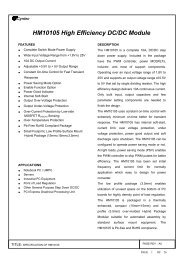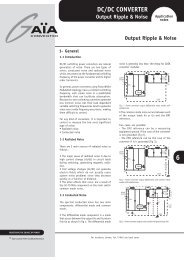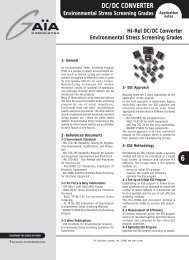HM03145 High Efficiency DC/DC Module
HM03145 High Efficiency DC/DC Module
HM03145 High Efficiency DC/DC Module
You also want an ePaper? Increase the reach of your titles
YUMPU automatically turns print PDFs into web optimized ePapers that Google loves.
APPLICATION INFORMATION<br />
The typical <strong>HM03145</strong> application circuit is<br />
shown in Figure 2. External component<br />
selection is primarily determined by the<br />
maximum load current and input / output<br />
voltage.<br />
Programming the Output Voltage<br />
The <strong>HM03145</strong> has an internal 0.5V ± 1.2%<br />
reference voltage. It only programs the<br />
dividing resistance R S1 and R S2 which respects<br />
to FB pin and AGND. The output voltage can<br />
be regulated as<br />
V<br />
ref<br />
= 0.5 = V<br />
out<br />
⎛<br />
× ⎜<br />
⎝ R<br />
R<br />
S1<br />
S 2<br />
+ R<br />
S 2<br />
The resistance respects to different output<br />
voltage are as following.<br />
Vout 0.9V 1.05V 1.2V 1.5V<br />
R S1<br />
10k<br />
R S2 12.5k 9.09k 7.143k 5k<br />
Vout 1.8V 2.5V 3.3V 5V<br />
R S1<br />
10k<br />
R S2 3.84k 2.5k 1.786k 1.11k<br />
Programming the Pseudo-Fixed PWM<br />
Switching Frequency with Constant<br />
On-time Control<br />
The PWM control architecture consists of a<br />
constant on-time, pseudo-fixed frequency<br />
controller. The output voltage ripple developed<br />
across the output capacitor’s ESR provides<br />
the PWM ramp signal eliminating. The<br />
high-side switch on-time is determined by<br />
one-shot whose period is directly proportional<br />
to output voltage and inversely proportional to<br />
input voltage. A second one shot sets the<br />
⎞<br />
⎟<br />
⎠<br />
minimum off-time which is typically 400nS. The<br />
on-time one shot comparator has two inputs. One<br />
input looks at the output voltage (Vo), while the<br />
other input samples the input voltage and<br />
converts it to a current. This input voltage<br />
proportional current is used to charge an internal<br />
on-time capacitor. The on-time is the time<br />
required for voltage on this capacitor to charge<br />
from zero to output voltage (Vo), thereby making<br />
the on-time of the high-side switch. This<br />
implementation results in a nearly constant<br />
switching frequency without need for a clock<br />
generator.<br />
Duty cycle will be decided by below formula:<br />
V T T<br />
D = = =<br />
V T + T T<br />
OUT ON ON<br />
IN ON OFF<br />
Where:<br />
D is the duty cycle.<br />
V OUT is the output voltage.<br />
V IN is the input voltage.<br />
T ON is the high-side switch on-time.<br />
T OFF is the high-side switch off-time.<br />
T is period of PWM.<br />
When the PWM switching frequency is<br />
determined, thereby the PWM period is inversely<br />
proportional to switching frequency as below.<br />
Then, high-side switch on-time (T ON ) can be<br />
calculated by duty and period of PWM.<br />
1<br />
T = F<br />
S<br />
VOUT<br />
TON<br />
=<br />
FS×<br />
VIN<br />
Where:<br />
Fs is the switching frequency.<br />
TITLE: SPECIFICATION OF <strong>HM03145</strong><br />
PAGE REV:A1<br />
PAGE 12 OF 30
















